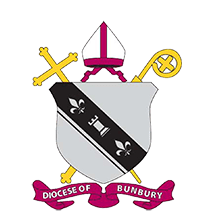Manjimup
The first Manjimup parish church was opened by Archbishop Clune on 6 September 1914 just as World War 1 broke out. With many of the men folk at war the congregations decreased, but Father Jeremiah Reidy continued to travel from Bridgetown by sulky (and later in a Model “T” Ford) to say Mass in Manjimup once a month. Manjimup developed due to the prospect of work, building timber mills, felling and milling timber. Manjimup became a separate parish in March 1922 with the appointment of Fr Kearnan. There being no residence for a priest in Manjimup, Father lived in Bridgetown during the week going to Manjimup to say Mass on the weekends.
The first Manjimup parish church was opened by Archbishop Clune on 6 September 1914 just as World War 1 broke out. With many of the men folk at war the congregations decreased, but Father Jeremiah Reidy continued to travel from Bridgetown by sulky (and later in a Model “T” Ford) to say Mass in Manjimup once a month. Manjimup developed due to the prospect of work, building timber mills, felling and milling timber. Manjimup became a separate parish in March 1922 with the appointment of Fr Kearnan. There being no residence for a priest in Manjimup, Father lived in Bridgetown during the week going to Manjimup to say Mass on the weekends.
With the area growing rapidly and using a bequest left by a former parishioner, a Philippine Islander, Thomas Menrique, a half acre of land was bought across the road from the recreation ground, for the building of a convent. This not being enough for the children to play on, options were taken to buy 4 adjoining blocks still in their virgin state. Fallers from nearby Dean Mill brought the bigger trees down and busy bees of parishioners cleared sufficient land for the convent. A residence was built which was first to serve as the presbytery and later as a Sisters’ convent. The Sisters of St Joseph arrived in April 1923. The biggest problem with schooling was that few of the Catholic children lived in the town itself. This meant provision had to be made for boarders. To accommodate the boarders a verandah was added to the Convent using one end for beds and the other end for a dining room. While still living in Bridgetown, Father Kearnan busied himself making tables, cupboards, blackboards and desks out of Shell petrol cases. To give the Sisters daily Mass, Father Kearnan left Bridgetown to live in the sacristy – an unlined room at the back of the church in Manjimup. Manjimup Convent School opened on 16.4.1923. A new brick, two storey building was opened late in 1925. This comprised of 4 classrooms downstairs and dormitories upstairs. The old church was sold to a family who then provided new material for building the school, Mass was then said in the passage of the convent – rows of two chairs ran the length of the passage, the altar crammed against the back door.
Starting in May 1927, children were brought in from outlying State schools to Manjimup to enjoy school holidays in the Convent whilst receiving sacramental instructions from the Sisters. In 1955 a new church was blessed and officially opened by Bishop Goody. Fr James McCarthy was our Parish priest at the time. Extensions continued to the school with the blessing and opening of Kearnan High School in 1972. Fr Stephen Kelly was the Parish Priest at the helm of all this building. He remained in Manjimup until 1979 watching the progress of the school to the completion state. Kearnan College, catering for children from Kindergarten to Year 12, is now a modern well equipped school. With the departure of the Sisters from Manjimup, a lay Principal was appointed to the school in 1994.
The old convent building has been refurbished to become the administration building for the school. In more recent years we have seen the building of a magnificent Parish Centre. This comprises several meeting rooms, hall, office, consulting room, kitchen, outdoor atrium area, resource room and toilet facilities. It is a truly wonderful asset for this parish and used extensively by the parish, the school, diocesan groups and other non-profit making organizations.
Patch Story
Panel 1 The Lily of Saint Joseph. This simply represents the patron saint of our parish. The brown background is a reminder of the presence of the Sisters of St. Joseph.
Panel 2 This panel signifies the pioneer spirit of the families and the priests and nuns that together founded the parish. Establishing their lives amongst the tall forests of the district was a test of their strength and resourcefulness. The background of red speaks of fire and the Spirit.
Panel 3 The image of the present church building for many parishioners, symbolizes the parish and its uniqueness. The blue means water. This is a reminder of all those that have been baptized under her roof.
Panel 4 This last panel is symbolic of who we strive to be as a parish. That is, reaching out to others to share our faith in the risen God, and our collective Christian journey under the wings of the Holy Spirit. The background of green signifies life.
The patch can be read from left to right as past to present to future. The dates represent the year the parish was founded and the year of Jubilee.
Ideas for the banner were collected at a parish workshop and represent the essence of the parish of St. Joseph’s in Manjimup in the year of Jubilee.
The banner was lovingly sewn by Marie Rooney and Diane Steber. The design was prepared by Tim Foley.
